プログラム
| 招待講演① 10:20~11:05 |
Design and Optimization of Mechanochemical Reactions: Exploring New Horizons in Organic Synthesis Prof. Hajime Ito Graduate School of Engineering and Institute for Chemical Reaction Design and Discovery (WPI-ICReDD), Hokkaido University |
|---|---|
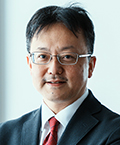 詳細をみるMechanochemical synthesis, which uses little to no solvent, is an alternative to the traditional organic synthesis performed in solution. Instead of the use of a solvent and glassware, mechanochemical reactions are performed using a ball mill or other pulverizing device. This method offers several advantages, such as reduced use of organic solvents, accelerated reactions due to high concentration conditions, ability to react with unsolvable compounds, activation of substrates via physical forces, and increased selectivity in a solid phase. Reducing organic solvents and increased reaction rates results in reduced waste and energy usage, making it an important development for future organic synthesis. In addition, it also offers a promising solution for reactions involving solids that do not dissolve, which has been a problem in organic synthesis. This talk will present our latest research results on the potential of this technique and its impact on the field of organic synthesis. |
|
| 招待講演② 11:10~11:55 |
Radical-Based Approach for Synthesis of Complex Natural Products Prof.Masayuki Inoue Graduate School of Pharmaceutical Sciences, The University of Tokyo |
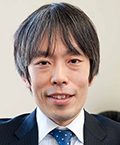 詳細をみるNatural products with a high ratio of sp3-hybridized atoms and oxygen-substituted stereogenic centers represent privileged structures for the development of pharmaceuticals and chemical probes. The multiple oxygen functionalities of these natural products endow their potent and selective biological activities, although they significantly heighten the challenge of their chemical assemblies. We focused on developing efficient strategies for the total syntheses of this biologically and chemically important class of molecules. A convergent strategy is more advantageous than a linear strategy for designing a shorter synthetic route because a convergent strategy enables direct coupling of functionalized fragments whereas a linear strategy involves stepwise construction of a molecule from its terminus. Radical reactions are preferred over polar reactions for the coupling of heavily functionalized and sp3-rich fragments, as they allow for C(sp3)-C(sp3) coupling without damaging diverse polar functional groups. With these considerations in mind, we designed radical-based convergent strategies for assembling highly oxygenated natural products such as resiniferatoxin, taxol, polyoxins, and hikizimycin. This lecture will describe our synthetic efforts toward a long-term goal of developing ideal convergent strategies for assembling and diversifying densely oxygenated natural products. We hope that the lecture exemplifies the present status of the challenges in the total synthesis of complex natural products, and fosters future trajectories in the field. |
|
| 招待講演③ 12:00~12:45 |
Chirality-switchable Helical Macromolecular Catalysts for Asymmetric Synthesis Prof. Michinori Suginome Graduate School of Engineering, Kyoto University |
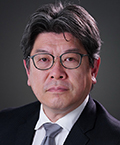 詳細をみるRemarkable development of asymmetric catalysis has been witnessed in the past half century with the discovery of a wide array of small-molecule-based chiral catalyst structures with fixed chirality. Meanwhile, little attention has been paid to chiral catalysts of which chirality is dynamic, even though such chirality-switchable catalysts may open up new possibilities of asymmetric synthesis. A major difficulty of such dynamic systems could be thermodynamic control of the catalyst conformation. Utilization of helical macromolecular structures is advantageous in this regard, because small thermodynamic imbalance at each monomer unit can be linearly accumulated in the helical main chain, leading to energy difference large enough to induce single-handed helical conformation. In this presentation, a series of new chiral catalysts based on helical poly(quinoxaline-2,3-diyl)s (PQX hereafter) are described whose helical chirality is thermodynamically induced. The helical structures are inverted sharply by the effect of solvents and additives, which interact with the polymer scaffold through nonbonding forces. PQXs containing catalyst groups showed high enantioselectivities, reusability, and catalyst activity in several metal-catalyzed and organocatalytic reactions. The ability of the helical macromolecular scaffold to accumulate weak nonbonding interaction enabled induction of single-handed screw-sense even to achiral PQX, which contains no chiral substituents, just by its dissolution in chiral solvents such as limonene. The first highly enantioselective reaction in which chiral solvent solely serves as the source of chirality was demonstrated by using the achiral PQX as a catalyst. Use of natural amino acid derivatives as chiral additives shall also be discussed. |
|
| 招待講演④ 13:50~14:35 |
Chemistry for Imaging and Target Identification of Bioactive Small Molecules Prof.Mikiko Sodeoka Chief Scientist RIKEN |
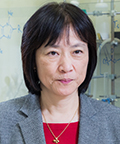 詳細をみるElucidation of the molecular mechanism of bioactive small molecule’s action is essential for using such molecule as a tool for biological research. In this talk, I would like to introduce a new turn-on fluorescence affinity labeling method using a compact NBD (nitrobenzoxadiazole) unit, which acts as both a fluorophore and a reactive group. This method is a powerful tool not only for target identification but also for protein complex analysis. In addition, a potential of Raman spectroscopy as a new modality for live cell imaging of small molecules will be also discussed. We have successfully demonstrated that Raman spectroscopy and a small bioorthogonal alkyne tag is a perfect combination for the imaging of small molecules. |
|
| 特別講演(1) 14:40~15:40 |
Asymmetric Catalysis with Peptides Prof. Helma Wennemers ETH Zürich |
 詳細をみるIn nature, proteins fulfill manifold different functions and are crucial as, for example, enzymes or templates for the controlled formation of structural components such as bones. The Wennemers group is intrigued by the question of whether also peptides with significantly lower molecular weights than proteins can fulfill functions for which nature evolved large macromolecules. Specifically, we ask whether peptides can serve as effective asymmetric catalysts, synthetic collagen-based materials, or imaging and targeting vectors. The lecture will focus on stereoselective peptide catalysts of the general type H-Pro-Pro-Xaa. These peptides allow for catalysis via an enamine intermediate with loadings of as little as 0.05–1 mol% and provide synthetically versatile products from aldol and conjugate addition reactions with high stereoselectivities. We will discuss the scope of the peptide-catalyzed reactions and insights into the mechanism. The lecture will also show the importance of the conformational properties of organocatalysts and highlight how changes in the conformational properties enable tuning of the catalytic activity, stereoselectivity, and chemoselectivity. |
|
| 招待講演⑤ 15:55~16:40 |
Chiral Phosphoric Acids as Versatile Enantioselective Catalysts Prof. Masahiro Terada Graduate School of Science,Tohoku University |
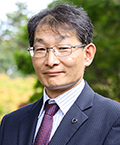 詳細をみるChiral Brønsted acid catalysts have emerged as a rapidly growing area of research in the past two decades. Among them, BINOL-derived axially chiral phosphoric acid catalysts (CPAs) represent a highly efficient and widely applicable class of chiral Brønsted acid catalysts that enabled a variety of organic transformations in a highly enantioselective fashion. Not only is the catalyst designed to increase acidity, but various C2 symmetrical skeletons have been reported, whereas BINOL derivatives were previously the parent chiral skeleton. Currently, reaction designs aided by computational science are also being demonstrated. The range of applicable reaction systems is still expanding widely. In this presentation, the achievements and recent progress of CPAs are overviewed. |
|
| 招待講演⑥ 16:45~17:30 |
Collective synthesis of natural products for elucidation of new biological activities Prof. Toshio Nishikawa Graduate School of Bioagricultural Sciences, Nagoya University |
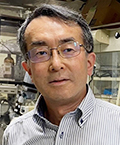 詳細をみるNatural products exhibiting unique and potent biological activities have played a significant role not only in drug discovery but also in the development of life sciences. However, most of natural products isolated so far has not been fully utilized for such purposes. In order to maximize the potential of natural products, we thus have developed methodologies for collective synthesis of several natural products with the aim of exploring their new and unique biological functions. In this symposium, collective synthesis of several natural products and our efforts to explore their new biological activities will be presented. The first example is synthesis of tetrodotoxin, a toxic principle of pufferfish intoxication. We have synthesized about twenty naturally occurring analogs of tetrodotoxin from two common intermediates by using unique reactivities of trichloroacetyl group, a protective group of amino function. The second example is synthesis of oscillatoxin/aplysiatoxin family, which is polyketide-derived natural product family isolated from marine cyanobactera. We have developed a bioinspired synthetic strategy of this class of natural products, which enables us to synthesize ten analogs such as oscillatoxin D, H, I, neo-debromoaplysiatoxin B, and H in a few steps respectively from a common intermediate. Details of the syntheses and our efforts to explore their new biological activities will be discussed. |
|
| 特別講演(2) 17:35~18:35 |
C-H Amidation Reactions via Nitrenoid Transfer: Scope and Mechanistic Aspects Prof. Sukbok Chang Korea Advanced Institute of Science and Technology (KAIST) |
 詳細をみるDirect amidation of C–H bonds is a highly desirable reaction considering high utility of amidated products in total synthesis, medicinal chemistry and materials science. Although tremendous research efforts have been made especially in recent years, the current status enabling such C–H reactions in excellent stereoselectivity and high efficiency is still rather limited. In this context, we have developed a novel methodology that employs tailor-made Ir-based catalysts in combination with dioxazolone substrates to access a short-lived metal-nitrenoid intermediate, thereby eventually leading to a construction of γ-lactams via an outer-sphere C–H insertion pathway. The scope was found to be broad and a range of carboxylic acids could be readily utilized for the lactam formation. More recently, we have successfully introduced an iridium-based catalyst system for asymmetric C–H amidation that enables facile construction of chiral γ-lactams starting from commodity chemicals. Various types of secondary C–H bonds, such as being positioned at the benzylic, unactivated aliphatic, propargylic, and allylic sites, were all smoothly reacted in a regio- and stereoselective manner. More recently, this strategy of C-N bond formation has been also successfully demonstrated to work with basic transition metal catalysts. The nitrenoid intermediacy was extensively investigated using mechanistic experiments, photocrystallography, and computational studies. The present approach will find broad applications in medicinal chemistry, and the mechanistic insights may provoke further developments in related asymmetric catalysis. |
